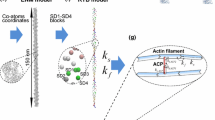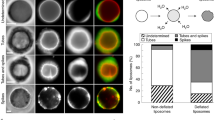Abstract
Studies of cell membrane fluctuations under micro rheological measurements suggest that coupling between the lipid bilayer and the actin cortex can affects viscoelastic behavior of the single cell membranes. Coupling induces anomalous nature of energy dissipation during rearrangement of both: the actin cortex and the lipid bilayer. The actin cortex ability to rearrange for various cell types: erythrocytes, Jurkat cells, fibroblasts, epithelial lung cells, and muscle cells based on experimental data for storage and loss moduli versus angular velocity are considered. The cortex of softer cells such as erythrocytes, Jurkat cells, and fibroblasts has the ability to rearrange at low angular velocities which is quantified by their rearrangement time and the average size of the cortex micro domains. The rearrangement time of the cortex for Jurkat cells and fibroblasts is at the order of magnitude higher than that for erythrocytes, i.e., 2.70–7.53 s. The average size of the cortex micro domains for erythrocytes varied from 3.0 to 5.3 μm, for Jurkat cells is ~0.20–0.22 μm and for fibroblasts is ~36 nm. Lower size of the micro domains and higher rearrangement time indicate the stiffer cortex structure. The cortex rearrangement for stiffer cells such as epithelial lung cells and muscle cells has never been observed.





Similar content being viewed by others
References
Alcaraz J, Buscemi L, Grabulosa M, Trepat X, Fabry B, Farre R, Navajas D (2003) Microrheology of human lung epithelial cells measured by atomic force microscopy. Biophys J 84:2071–2079
Almenar-Queralt A, Gregorio CC, Fowler VM (1999) Tropomodulin assembles early in myofibrillogenesis in chick skeletal muscle: evidence that thin filaments rearrange to form striated myofibrils. J Cell Sci 112:1111–1123
Amin MS, Park YK, Lue N, Dasari RR, Badizadegan K, Feld MS, Popescu G (2007) Microrheology of red blood cell membrane using dynamics scattering microscopy. Opt Express 15(25):17001–17009
Bausch AR, Ziemann F, Boulbitc AA, Jacobson K, Sackmann E (1998) Local measurements of viscoelastic parameters of adherent cell surfaces by magnetic bead microrheometry. Biophys J 75:2038–2049
Borukhov I, Bruinsma RF, Gelbart WM, Liu AJ, Lubensky TC (2005) Structural polymorphism of the cytoskeleton: a model of linker-assisted filament aggregation. PNAS 102(10):3673–3678
Cai X, Xing X, Cai J, Chen Q, Wu S, Huang F (2010) Connection between biomechanics and cytoskeleton structure of lymphocyte and Jurkat cells: an AFM study. Micron 41:257–262
Charras GT, Hu CK, Coughlin M, Mitchison TJ (2006) Reassembly of contractile actin cortex in cell biology. J Cell Biol 175(3):477–490
Dalhaimer P, Discher DE, Lubensky TC (2007) Crosslinked actin network show liquid crystal elastomeric behavior, including soft-mode elasticity. Nature Phys 3:354–360
Djordjevic VD, Jaric J, Fabrz B, Fredberg JJ, Stamenovic D (2003) Fractional derivatives embody essential features of cell rheological behavior. Ann Biomed Eng 31:692–699
Dustin ML, Davis SJ (2014) TCR signaling: the barrier within. Nature Immunol 15:136–137
Fabry B, Maksym GN, Butler JP, Glogauer M, Navajas D, Fredberg JJ (2001) Scaling the microrheology of living cells. Phys Rev Let 87(14):148102-1-4
Feneberg W, Aepfelbacher M, Sackmann E (2004) Microviscoelasticity of the apical cell surface of human umbilical vein endothelial cells (HUVEC) within confluent monolayers. Biophys J 87:1338–1350
Gov NS (2007) Less is more: removing membrane attachments stiffness the RBC cytoskeleton. New J Phys 9(429):1–8
Harland CW, Bradley MJ, Parthasarathy R (2011) Retraction for “Phospholipid bilayers are viscoelastic”, by Harland CW, Bradley MJ, Parthasarathy R, which appeared in PNAS 2011, 107(45), pp. 19146–19150, (2010). PNAS 108(35):14705
Jonas M, Chung E, Kim YH, So PTC (2006) Cytoskeletal mechanics fast fluorescence microrheology. GEM4—August 2006—MIT So Lab—FLTM, 1–3
Kuznetsova TG, Maria N, Starodubtseva MN, Yegorenkov NI, Chizhik SA, Zhdanov RI (2007) Atomic force microscopy probing of cell elasticity. Micron 38:824–833
Mangeat P, Burridge K (1984) Actin-membrane interaction in fibroblast: what proteins are involved in this association? J Cell Biol 99(1):95s–103s
Mikhalyov I, Samsonov A (2011) Lipid raft detecting in membranes of live erythrocytes. Biochem Biophys Acta 1808:1930–1939
Mofrad MRK, Karcher H, Kamm RD (2006) Continuum elastic or viscoelastic models for the cell. In: Mofrad MRK, Kamm RD (eds) Cytoskeletal mechanics, models and measurement. Cambridge University Press, New York, pp 71–84
Pajic-Lijakovic I, Milivojevic M (2014) Modeling analysis of the lipid bilayer-cytoskeleton coupling in erythrocyte membrane. Biomech Model Mechanobiol. doi:10.1007/s10237-014-0559-7
Peng Z, Zhu Q (2013) Deformation of the erythrocyte cytoskeleton in tank treading motions. Soft Matter 9:7617–7627
Podlubny I (1999) Fractional differential equations, mathematics in science and engineering, vol 198. Academic Press, London, p 78
Popescu G, Park YK, Dasari RR, Badizadegan K, Feld MS (2007) Coherence properties of red blood cell membrane motion. Phys Rev E 76:031902-1-5
Pradhan D, Tseng K, Cianci CD, Morrow JS (2004) Antibodies to hIA2 spectrin identify in-homogeneities in the erythrocyte membrane skeleton. Blood Cells Mol Dis 32:408–410
Puig-de-Morales-Marinkovic M, Turner KT, Butler JP, Fredberg JJ, Suresh S (2007) Viscoelasticity of the human red blood cell. Am J Physiol Cell Physiol 293:C597–C605
Wagh AA, Roan E, Waters CM (2008) Localized elasticity measured in epithelial cells migrating at a wound edge using atomic force microscopy. Am J Phisiol Lung Cell Mol Physiol 295(1):L54–L60
Wagner B, Tharmann R, Haase I, Fischer M, Bausch AR (2006) Cytoskeletal polymer networks: the molecular structure of cross-linkers determines macroscopic properties. PNAS 103(38):13974–13978
Warren RL, Tassieri M, Li X, Glidle A, Paterson DJ, Carlsson A, Cooper JM (2013) Rheology at the micro-scale: new tools for bioanalysis. In: Optical methods for inspection, characterization and imaging of biomaterials, 13–16, Munich, Germany, Proc SPIE Vol. 8792, p. 8792141 1-13
Acknowledgments
The authors gratefully acknowledge funding support of the Ministry of Education, Science and Technological Development of the Republic Serbia (Grants III 46001, and III 46010).
Conflict of interest
The author reports no conflict of interest.
Author information
Authors and Affiliations
Corresponding author
Rights and permissions
About this article
Cite this article
Pajic-Lijakovic, I., Milivojevic, M. Actin Cortex Rearrangement Caused by Coupling with the Lipid Bilayer-Modeling Considerations. J Membrane Biol 248, 337–347 (2015). https://doi.org/10.1007/s00232-015-9775-z
Received:
Accepted:
Published:
Issue Date:
DOI: https://doi.org/10.1007/s00232-015-9775-z




